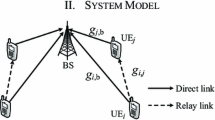Abstract
In commercial networks, user nodes operating on batteries are assumed to be selfish to consume their resources (i.e., bandwidth and power) solely maximizing their own benefits (e.g., the received signal-tonoise ratios (SNRs) and datarates). In this paper, a cooperative game theoretical framework is proposed to jointly perform the bandwidth and power allocation for selfish cooperative relay networks. To ensure a fair and efficient resource sharing between two selfish user nodes, we assume that either node can act as a source as well as a potential relay for each other and either node is willing to seek cooperative relaying only if the datarate achieved through cooperation is not lower than that achieved through noncooperation (i.e., direct transmission) by consuming the same amount of bandwidth and power resource. Define the cooperative strategy of a node as the number of bandwidth and power that it is willing to contribute for relaying purpose. The two node joint bandwidth and power allocation (JBPA) problem can then be formulated as a cooperative game. Since the Nash bargaining solution (NBS) to the JBPA game (JBPAG) is computationally difficult to obtain, we divide it into two subgames, i.e., the bandwidth allocation game (BAG) and the power allocation game (PAG). We prove that both the subgames have unique NBS. And then the suboptimal NBS to the JBPAG can be achieved by solving the BAG and PAG sequentially. Simulation results show that the proposed cooperative game scheme is efficient in that the performance loss of the NBS result to that of the maximal overall data-rate scheme is small while the maximal-rate scheme is unfair. The simulation results also show that the NBS result is fair in that both nodes could experience better performance than they work independently and the degree of cooperation of a node only depends on how much contribution its partner can make to improve its own performance.
Similar content being viewed by others
References
Sendonaris A, Erkip E, Aazhang B. User cooperation diversity-part I: system description IEEE Trans Commun, 2003, 51: 1927–1938
Laneman J N, Tse D N C, Wornell G W. Cooperative diversity in wireless networks: efficient protocols and outage behavior. IEEE Trans Inforam Theory, 2004, (50): 3062–3080
Beres E, Adve R. Selection cooperation in multi-source cooperative networks IEEE Trans Wirel Commun, 2008, 7: 118–127
Zhao B Valenti M C. Practical relay networks: a generalization of hybrid-ARQ IEEE J Sel Area Comm, 2005, 23: 7–18
Luo J, Blum R S, Greenstein L J, et al. New approaches for cooperative use of multiple antennas in ad hoc wireless networks. In: Proceedings of IEEE 60th Vehicular Technology Conference. Bethlehem: IEEE, 2004. 2769–2773
Ibrahim A S, Sadek A K, Su W F, et al. Cooperative communications with relay-selection: when to cooperate and whom to cooperate with? IEEE Trans Wirel Commun, 2008, 7: 2814–2827
Himsoon T, Siriwongpairat W, Han Z, et al. Lifetime maximization framework by cooperative nodes and relay deployment in wireless networks. IEEE J Sel Area Comm, 2007, 25: 306–317
Zhang Z, Chen H H, Qiu P. A cooperation strategy based on nash bargaining solution in cooperative relay networks. IEEE Trans Veh Technol, 2008, 57: 2570–2577
Zhang G P, Cong L, Yang K, et al. Competitive resource sharing based on game theory in cooperative relay networks. ETRI J, 2009, 31: 89–91
Cong L, Yang K, Zhang G P. Stackelberg game for resource allocation in multiuser cooperative transmission networks. Wiley J Wirel Comm Mobile Comput (WJ-WCMC), 2011, 11: 129–141
Cong L, Yang K, Zhang G P. Pricing-based game for spectrum allocation in multi-relay cooprative transmission networks. IET Commun, 2011 5: 563–573
Zhang G P, Wang W, Zhao L Q. Fair resource sharing for cooperative relay networks using Nash bargaining solutions. IEEE Commun Lett 2009, 13: 381–383
Zhang G P, Yang K Ding E J. Power allocation scheme for selfish cooperative communications based on game theory and particle swarm optimizer. Sci China Inf Sci, 2010, 53: 1908–1912
Ding E J, Zhang G P, Liu P, et al. Energy-efficient power allocation for selfish cooperative communication networks using bargaining game. Sci China Inf Sci, 2012, 55: 795–804
Wang B, Han Z, Liu K J R. Distributed relay selection and power control for multiuser cooperative communication networks using Stackelberg game. IEEE Trans Mobile Comput 2009, 8: 975–990
Huang J W, Han Z, Liu K J R, et al. Auction-based resource allocation for cooperative communications. IEEE J Sel Area Comm, 2008, 26: 1226–1237
Krishna V. Auction Theory. London: Academic Press, 2002
Fudenberg D, Tirole J. Game Theory. Cambridge: MIT Press, 1991
Wang J Chen J. Performance of wideband CDMA systems with complex spreading and imperfect channel estimation. IEEE J Sel Area Comm, 2001, 19: 152–163
Wang J, Milstein L B. CDMA overlay situations for microcellular mobile communications. IEEE Trans Commun, 1995, 43: 603–614
Cui S G, Goldsmith A J, Bahai A. Energy-efficiency of MIMO and cooperative MIMO techniques in sensor networks. IEEE J Sel Area Comm, 2004, 22: 1089–1098
Han Z, Ji Z, Liu K J R. Fair multiuser channel allocation for OFDMA networks using Nash bargaining solutions and coalitions. IEEE Trans Commun, 2005, 53: 1366–1376
Cao X R. Preference functions and bargaining solutions. In: Proceedings of IEEE Conference on Decision and Control. Orlando: IEEE, 1982. 164–171
Zhang G, Cong L, Ding E, et al. Fair and efficient resource sharing for selfish cooperative communication networks using cooperative game theory. In: Proceedings of IEEE International Conference on Communications (ICC 2011). Kyoto: IEEE, 2011. 1–5
Boyd S, Vandenberghe L. Convex Optimization. London: Cambridge University Press, 2004
Shi Y, Eberhart R C. A modified particle swarm optimizer. In: Proceedings of IEEE International Conference on Evolutionary Computation. Anchorage: IEEE, 1998. 69–73
Author information
Authors and Affiliations
Corresponding author
Rights and permissions
About this article
Cite this article
Zhang, G., Ding, E., Yang, K. et al. A suboptimal joint bandwidth and power allocation for cooperative relay networks: a cooperative game theoretic approach. Sci. China Inf. Sci. 56, 1–12 (2013). https://doi.org/10.1007/s11432-011-4473-7
Received:
Accepted:
Published:
Issue Date:
DOI: https://doi.org/10.1007/s11432-011-4473-7




